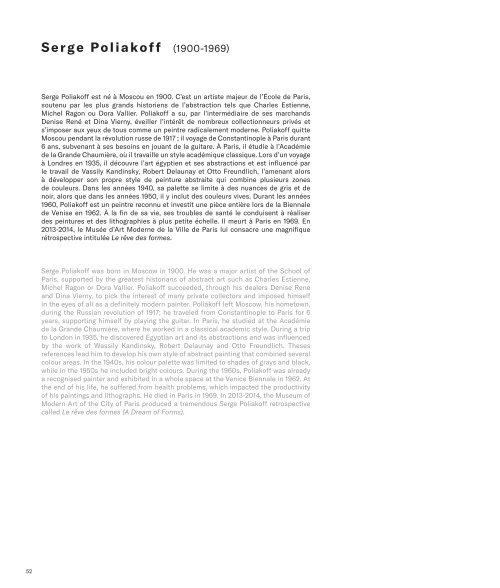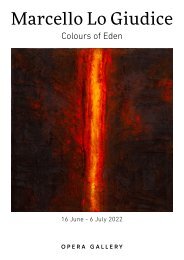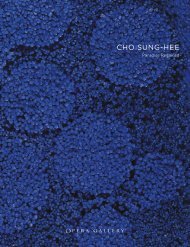les maitres de l'abstraction - web
You also want an ePaper? Increase the reach of your titles
YUMPU automatically turns print PDFs into web optimized ePapers that Google loves.
Serge Poliakoff (1900-1969)<br />
Serge Poliakoff est né à Moscou en 1900. C’est un artiste majeur <strong>de</strong> l’École <strong>de</strong> Paris,<br />
soutenu par <strong>les</strong> plus grands historiens <strong>de</strong> l’<strong>abstraction</strong> tels que Char<strong>les</strong> Estienne,<br />
Michel Ragon ou Dora Vallier. Poliakoff a su, par l’intermédiaire <strong>de</strong> ses marchands<br />
Denise René et Dina Vierny, éveiller l’intérêt <strong>de</strong> nombreux collectionneurs privés et<br />
s’imposer aux yeux <strong>de</strong> tous comme un peintre radicalement mo<strong>de</strong>rne. Poliakoff quitte<br />
Moscou pendant la révolution russe <strong>de</strong> 1917 ; il voyage <strong>de</strong> Constantinople à Paris durant<br />
6 ans, subvenant à ses besoins en jouant <strong>de</strong> la guitare. À Paris, il étudie à l’Académie<br />
<strong>de</strong> la Gran<strong>de</strong> Chaumière, où il travaille un style académique classique. Lors d’un voyage<br />
à Londres en 1935, il découvre l’art égyptien et ses <strong>abstraction</strong>s et est influencé par<br />
le travail <strong>de</strong> Vassily Kandinsky, Robert Delaunay et Otto Freundlich, l’amenant alors<br />
à développer son propre style <strong>de</strong> peinture abstraite qui combine plusieurs zones<br />
<strong>de</strong> couleurs. Dans <strong>les</strong> années 1940, sa palette se limite à <strong>de</strong>s nuances <strong>de</strong> gris et <strong>de</strong><br />
noir, alors que dans <strong>les</strong> années 1950, il y inclut <strong>de</strong>s couleurs vives. Durant <strong>les</strong> années<br />
1960, Poliakoff est un peintre reconnu et investit une pièce entière lors <strong>de</strong> la Biennale<br />
<strong>de</strong> Venise en 1962. À la fin <strong>de</strong> sa vie, ses troub<strong>les</strong> <strong>de</strong> santé le conduisent à réaliser<br />
<strong>de</strong>s peintures et <strong>de</strong>s lithographies à plus petite échelle. Il meurt à Paris en 1969. En<br />
2013-2014, le Musée d’Art Mo<strong>de</strong>rne <strong>de</strong> la Ville <strong>de</strong> Paris lui consacre une magnifique<br />
rétrospective intitulée Le rêve <strong>de</strong>s formes.<br />
Serge Poliakoff was born in Moscow in 1900. He was a major artist of the School of<br />
Paris, supported by the greatest historians of abstract art such as Char<strong>les</strong> Estienne,<br />
Michel Ragon or Dora Vallier. Poliakoff succee<strong>de</strong>d, through his <strong>de</strong>alers Denise Rene<br />
and Dina Vierny, to pick the interest of many private collectors and imposed himself<br />
in the eyes of all as a <strong>de</strong>finitely mo<strong>de</strong>rn painter. Poliakoff left Moscow, his hometown,<br />
during the Russian revolution of 1917; he traveled from Constantinople to Paris for 6<br />
years, supporting himself by playing the guitar. In Paris, he studied at the Académie<br />
<strong>de</strong> la Gran<strong>de</strong> Chaumière, where he worked in a classical aca<strong>de</strong>mic style. During a trip<br />
to London in 1935, he discovered Egyptian art and its <strong>abstraction</strong>s and was influenced<br />
by the work of Wassily Kandinsky, Robert Delaunay and Otto Freundlich. Theses<br />
references lead him to <strong>de</strong>velop his own style of abstract painting that combined several<br />
colour areas. In the 1940s, his colour palette was limited to sha<strong>de</strong>s of grays and black,<br />
while in the 1950s he inclu<strong>de</strong>d bright colours. During the 1960s, Poliakoff was already<br />
a recognised painter and exhibited in a whole space at the Venice Biennale in 1962. At<br />
the end of his life, he suffered from health problems, which impacted the productivity<br />
of his paintings and lithographs. He died in Paris in 1969. In 2013-2014, the Museum of<br />
Mo<strong>de</strong>rn Art of the City of Paris produced a tremendous Serge Poliakoff retrospective<br />
called Le rêve <strong>de</strong>s formes (A Dream of Forms).<br />
Serge Poliakoff<br />
Composition murale, 1966<br />
Signed on the lower right<br />
Tempera on paper laid on canvas<br />
100 x 80,4 cm I 39.4 x 31.5 in<br />
Exhibited<br />
Reims, Maison <strong>de</strong> la Culture André Malraux, Serge Poliakoff, May - July 1971<br />
Milano, Centro Rizzoli, Serge Poliakoff, February - March 1972<br />
Lisbon, Galeria S. Mamè<strong>de</strong>, Poliakoff, November - December 1972<br />
Rome, Galleria Editalia, Serge Poliakoff, October - November 1973<br />
Tehran, Centre International <strong>de</strong>s Arts, 1er Salon International <strong>de</strong>s Arts AFAA, March 1975<br />
Hovikod<strong>de</strong>n, Sonja Henie-Onstad Kunstsenter, Poliakoff, February - March 1976<br />
St. Gallen, Galerie im Erker, Serge Poliakoff, June - October 1996<br />
Literature<br />
Alexis Poliakoff, Serge Poliakoff, Catalogue raisonné, Volume V, 1966-1969, Éditions Galerie Française, Paris 2016, p. 90, ill.<br />
Giuseppe Marchiori, Serge Poliakoff, Les Presses <strong>de</strong> La Connaissance, 1976, p. 7, ill.<br />
Marie Victoire Poliakoff, Serge Poliakoff mon grand-père, Éditions du Chêne, Paris 2011, p. 212, ill.<br />
52<br />
53

















